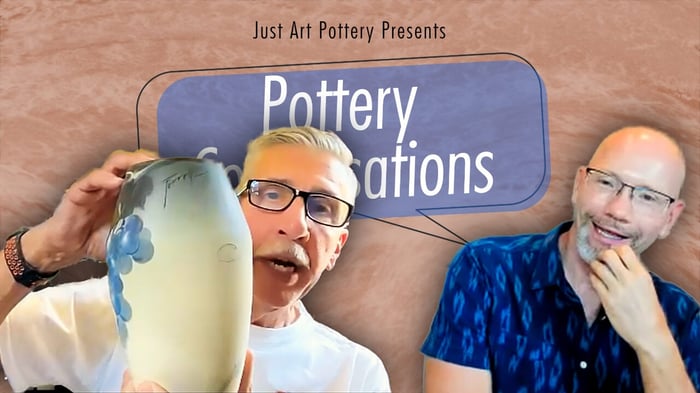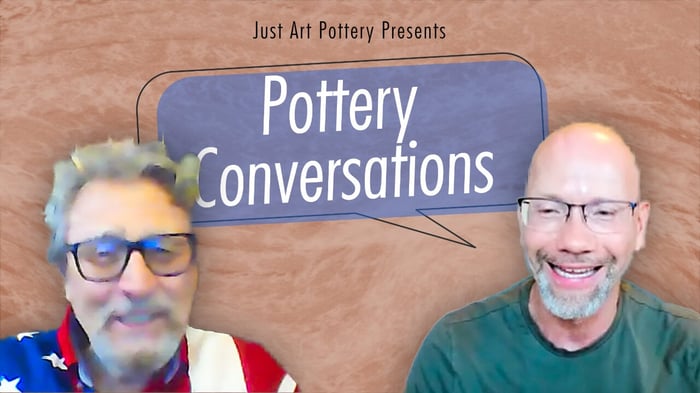Welcome to Pottery Conversations hosted by JustArtPottery.com Owner, Greg Myroth, where we delve into the world of vintage and collectible art pottery! From renowned experts and authors to passionate collectors and seasoned dealers, we'll bring you insightful conversations that celebrate the beauty and craftsmanship of American art pottery and European ceramics. Whether you're a seasoned collector or just beginning your journey into the world of art pottery, there's something for everyone on Pottery Conversations. Subscribe and stay tuned for uploads and highlights from each episode.
Weller Pottery with Frank Norman - Pottery Conversations - Episode 5
On this episode of Pottery Conversations, we welcome author Frank Norman! Frank discusses his motivations for writing two books, what he's learned collecting vintage Weller pottery, why some Sicards are better than others, and his restored period correct farm.
0:00 - Start
00:36 - Frank's Period Correct Farm Restoration
04:45 - Frank's Books
06:25 - Why Choose Weller?
10:18 - Weller Unknowns: What Led Frank To Write His Book?
15:30 - What Glaze Lines Should New Collectors Look For?
17:57 - The Value Of Sicard
21:37 - What Else Do You Look For When Evaluating Quality?
23:38 - Flaws: Are They Acceptable?
26:29 - To Repair Or Not To Repair?
29:36 - Advice For Upgrading Pottery Collections
31:39 - When Trading Up, DON'T Sell Everything!
34:14 - Is Weller's Matte Green Really That Good?
38:52 - Hudson Light/Eocean Matte Wear
47:12 - If The Artist Doesn't Sign It, Does That Change The Value?
49:11 - Why Do We See Inconsistencies Between Weller Pieces?
54:15 - Molded Weller, In Unique Shapes?!
56:46 - Closing Remarks
01:03:38 - Outro
SUBSCRIBE for more Pottery Conversations episodes and highlights: www.youtube.com/@justartpottery
More Information and Links:
Learn More About Weller Pottery
"Weller Pottery - A Clearer Vision" by Frank Norman
"Collecting Weller Pottery - A Collector's Perspective" by Frank Norman
Summary of Episode 5
In this episode, Frank Norman, a friend and author who extensively researches Weller pottery, shares his passion for restoring a 1770's period farm. After meticulously restoring the historic home and barn, Frank set out to populate the farm with the original livestock that would have been present in the 1770s, including rare and endangered breeds such as Old English geese, Roman-era chickens, and Narragansett turkeys. Through his research and connections with breed preservation societies, Frank was able to acquire these period-accurate animals, bringing the farm back to its 18th-century roots and providing insight into his holistic approach to preserving history. Frank and his wife got involved with raising Leicester long wool sheep, in addition to their full-time jobs and pottery collecting.
Frank's book on Weller pottery is a standout for the listener who appreciates how Frank weaves personal stories along with the decision-making process behind acquiring rare pieces. There is an impressive level of detail and thoroughness in Frank's research, which makes the book an engaging read beyond a typical pottery textbook.
Frank's passion for antiques and auctions was sparked when his brother-in-law visited, leading him to explore the antique shops and auctions in the Adamstown, Pennsylvania area, which ultimately fueled his interest in Weller pottery. The speaker shares their journey into pottery collecting, starting with Roseville and then discovering a deep fascination with Weller pottery. They describe the thrill of finding an unmarked Weller piece at an auction and the challenge of researching and authenticating the pottery, as the available information was limited at the time.
This experience ultimately led the speaker to decide to write a book on Weller pottery, in order to share their knowledge and help other collectors navigate the complexities of this lesser-known pottery brand. Norman shares his journey into pottery collecting, starting with an initial fascination with the "Weller feel" and then diving deeper into the hobby. They describe their eye-opening experience at the Pottery Lovers show in Zanesville, where they were inspired to start collecting and sharing the stories behind the pieces.
Encouraged by friends, the speaker decided to write a book to share his knowledge and help other new collectors navigate the intricacies of Weller pottery, including tips on identifying repairs and understanding the specialized vocabulary. The speaker's background as a teacher also motivated them to "give back" through the book. The experienced collector advises the beginner to focus on acquiring the best quality and condition pieces, rather than trying to amass a large collection. They highlight the artistic merit and value of underappreciated Weller lines like Eocean and Hudson, which have seen a downturn in prices compared to more popular lines.
The collector suggests looking beyond just comparing pieces within the same line, and considering how they stack up against similar high-quality ceramic works from other makers like Rookwood. Overall, the advice emphasizes quality over quantity and identifying hidden gems in the Weller market. The speakers discuss the importance of quality and artistry when evaluating Sicard pottery. They caution that just because a piece has the Sicard name, it doesn't automatically make it valuable. The best Sicard pieces are characterized by a thick, vibrant glaze and exceptional craftsmanship.
The speakers also emphasize the importance of hands-on experience in developing an eye for quality, using the example of Timberlake's exceptional Hudson pieces. Their advice to collectors is to extensively research and handle many examples before making purchasing decisions. The speakers discuss the nuances of collecting pottery and ceramics, particularly the importance of condition when evaluating potential purchases. Some have become less rigid about accepting pieces with minor flaws or damage, as long as the item is rare and the damage is not overly obtrusive. Norman advises that it's important to develop a strong knowledge base to quickly identify valuable pieces, even if they are not in perfect condition. The speakers also touch on the preference for leaving some minor imperfections rather than fully restoring a piece, as this can sometimes be more desirable for collectors.
The speakers discuss the challenges and strategies involved in upgrading a pottery collection and the importance of considering the current market value and popularity of different pottery lines when deciding what to sell or keep. They also compare the costs and benefits of selling through auction houses, online platforms like eBay, and directly to dealers. The key is to carefully evaluate the various options to get the best return on your collection as your interests and priorities evolve over time.
We explore the underappreciated quality of Weller's matte green glazes, which we believe deserve more recognition and demand compared to similar Arts and Crafts pottery and despite its commercial production. While some may view Weller as less prestigious than other art potteries, the speakers argue that the Matte Green pieces hold their own when compared side-by-side. They also note that Weller had a strong quality assurance process, selling pieces with minor flaws at a lower price.
Then, Frank's research on Hudson Light has shed new light on this intriguing Weller pottery line. By examining a rare salesman's catalog from the 1910s, Frank discovered that Hudson Light was actually part of Weller's "Eocean Matware" line, providing valuable insights into the origins and production details of this previously mysterious pottery. Frank's dedication to uncovering the history and context behind Weller's work has helped to deepen our understanding of this fascinating aspect of American ceramics. The speaker discusses their research on Weller Pottery, specifically the Eocean matte glaze. They describe finding a lamp base at a New England auction that was marked as Eocean matte, which helped support their theory that the Eocean matte glaze was used more extensively than previously thought. The speaker also recently acquired a piece of Eocean matte pottery that is clearly marked "Eocean" on the bottom, providing further evidence to counter skeptics who questioned the pencil markings. Additionally, the speaker mentions finding a piece signed by Farrell, suggesting he may have returned to Weller during a specific timeframe, which the speaker plans to explore in their second book.
The speaker discusses the challenges Weller Pottery faced in producing art pottery for the masses. They explain that Weller hired a mix of skilled artists and factory workers, many of whom were immigrants who could barely speak or write English. This led to inconsistencies in the markings on Weller pieces, with some being signed and others not. The speaker notes that Weller prioritized speed and efficiency in production, which contributed to these variations. They suggest that understanding this context can help collectors better appreciate the nuances and value of Weller pottery.
The conversation explores the challenges of collecting early Weller pottery, where inconsistencies in marking and production volumes led to confusion for collectors. The speaker emphasizes that the quality and condition of a piece are more important than whether it is properly marked. They also discuss how Weller's openness to experimentation resulted in unique, one-off designs, which can be difficult to find and authenticate. The key insights are that collectors should focus on the overall quality and craftsmanship of a Weller piece, rather than getting caught up in issues of marking or rarity.
The speakers discuss the factors that influenced the mass production decisions of an art pottery maker. Key considerations included the cost and time required to produce the pieces, the success rate of the firing process, and the popularity of the designs among distributors and customers. The pottery maker aimed to strike the right balance between creativity and commercial viability, discontinuing designs that did not gain enough traction in the market. The conversation highlights the pragmatic, business-oriented approach the maker took in determining which pottery designs to mass produce.
Greg and Frank discuss the importance of keeping interest and enthusiasm alive for pottery collecting and preservation. Greg shares his goal of propagating pottery to other small collectors and getting people excited about collecting, overcoming any fears or misconceptions. He sees these podcast conversations as a valuable way to share information and insights, especially for customers who may not attend shows or read books. The conversation highlights the challenges and rewards of this niche hobby, offering insights and inspiration for others interested in exploring the world of vintage collectibles.











